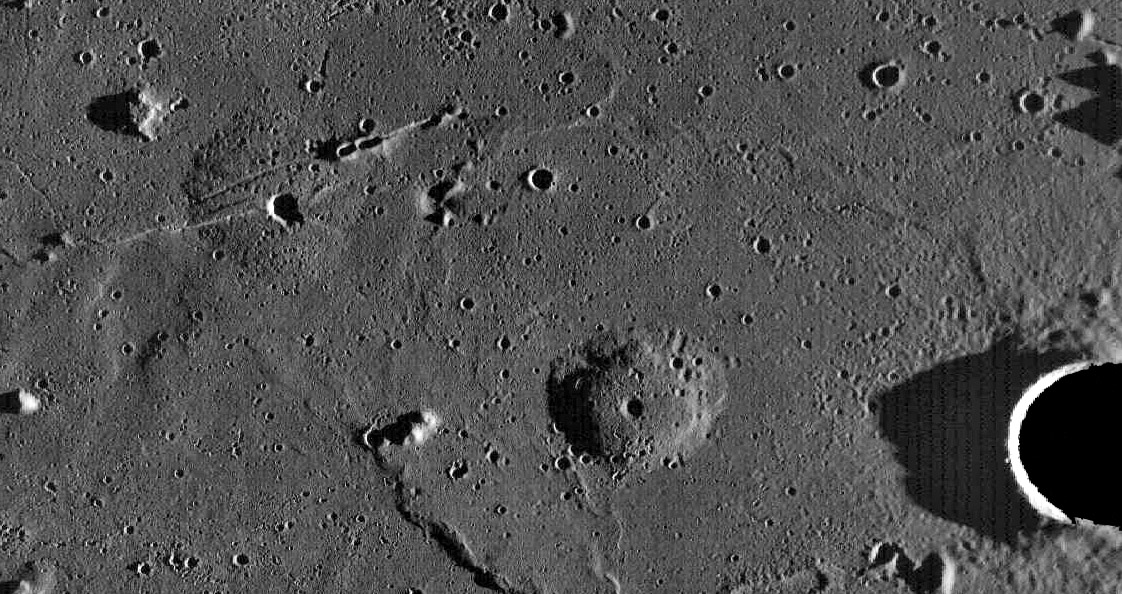Difference between revisions of "March 9, 2011"
| Line 1: | Line 1: | ||
__NOTOC__ | __NOTOC__ | ||
=Dome Closeup= | =Dome Closeup= | ||
| − | |||
<!-- ws:start:WikiTextHeadingRule:0:<h1> --> | <!-- ws:start:WikiTextHeadingRule:0:<h1> --> | ||
<!-- ws:start:WikiTextLocalImageRule:6:<img src="/file/view/LPOD-Mar9-11.jpg/208631568/LPOD-Mar9-11.jpg" alt="" title="" /> -->[[File:LPOD-Mar9-11.jpg|LPOD-Mar9-11.jpg]]<!-- ws:end:WikiTextLocalImageRule:6 --><br /> | <!-- ws:start:WikiTextLocalImageRule:6:<img src="/file/view/LPOD-Mar9-11.jpg/208631568/LPOD-Mar9-11.jpg" alt="" title="" /> -->[[File:LPOD-Mar9-11.jpg|LPOD-Mar9-11.jpg]]<!-- ws:end:WikiTextLocalImageRule:6 --><br /> | ||
| Line 9: | Line 8: | ||
for the nearby prominent - at least as much as they can be - dome. Named Milichius Pi on the <em>System of Lunar</em> <br /> | for the nearby prominent - at least as much as they can be - dome. Named Milichius Pi on the <em>System of Lunar</em> <br /> | ||
<em>Craters</em> charts, this feature has been known at least since 1931 when Elger called it a dome. It was one of the early <br /> | <em>Craters</em> charts, this feature has been known at least since 1931 when Elger called it a dome. It was one of the early <br /> | ||
| − | features studied by the [http://www.christian-woehler.de/lunar_domes_spectrophot_morph_icarus.pdf Geologic Lunar Research] group who labelled it M12 and found it to be 9.7 km in diameter <br /> | + | features studied by the [http://www.christian-woehler.de/lunar_domes_spectrophot_morph_icarus.pdf" rel="nofollow Geologic Lunar Research] group who labelled it M12 and found it to be 9.7 km in diameter <br /> |
and about 230 m high. It has a very common dome shape, a flattened plateau surrounded by acarp (but still a relat-<br /> | and about 230 m high. It has a very common dome shape, a flattened plateau surrounded by acarp (but still a relat-<br /> | ||
ively low slope), with a rimless crater on top. To the upper left is another common type of dome. This seems to have<br /> | ively low slope), with a rimless crater on top. To the upper left is another common type of dome. This seems to have<br /> | ||
| Line 18: | Line 17: | ||
apart this piece of crust, causing the rille to form.<br /> | apart this piece of crust, causing the rille to form.<br /> | ||
<br /> | <br /> | ||
| − | <em>[mailto:tychocrater@yahoo.com Chuck Wood]</em><br /> | + | <em>[mailto:tychocrater@yahoo.com" rel="nofollow Chuck Wood]</em><br /> |
<br /> | <br /> | ||
<strong>Related Links</strong><br /> | <strong>Related Links</strong><br /> | ||
Rükl plate [http://the-moon.wikispaces.com/R%C3%BCkl+30 30]<br /> | Rükl plate [http://the-moon.wikispaces.com/R%C3%BCkl+30 30]<br /> | ||
| − | [http://digilander.libero.it/glrgroup/consolidatedlunardomecatalogue.htm Consolidated Lunar Dome Catalogue]<br /> | + | [http://digilander.libero.it/glrgroup/consolidatedlunardomecatalogue.htm" rel="nofollow Consolidated Lunar Dome Catalogue]<br /> |
<br /> | <br /> | ||
<hr /> | <hr /> | ||
Revision as of 22:13, 4 January 2015
Dome Closeup

LRO WAC image processed byRick Evans (I think)
Milichius (bottom right) is a standard small impact crater 12 km in diameter, but it has been a valuable guidepost
for the nearby prominent - at least as much as they can be - dome. Named Milichius Pi on the System of Lunar
Craters charts, this feature has been known at least since 1931 when Elger called it a dome. It was one of the early
features studied by the " rel="nofollow Geologic Lunar Research group who labelled it M12 and found it to be 9.7 km in diameter
and about 230 m high. It has a very common dome shape, a flattened plateau surrounded by acarp (but still a relat-
ively low slope), with a rimless crater on top. To the upper left is another common type of dome. This seems to have
a more gentle continuous slope and less flattening across the top. Possibly it too is circled by a scarp, but if so it has
been covered by what appears to be subsequent lava flows. This dome is crossed by a rille which has two or three
volcanic cones at its northern end. GLR also studied the largest cone, which they call MC1, and found it to be 1.8 km
wide and 61 m high. These cones probably formed by a slight escape of magma from the underlying dike that wedged
apart this piece of crust, causing the rille to form.
" rel="nofollow Chuck Wood
Related Links
Rükl plate 30
" rel="nofollow Consolidated Lunar Dome Catalogue



